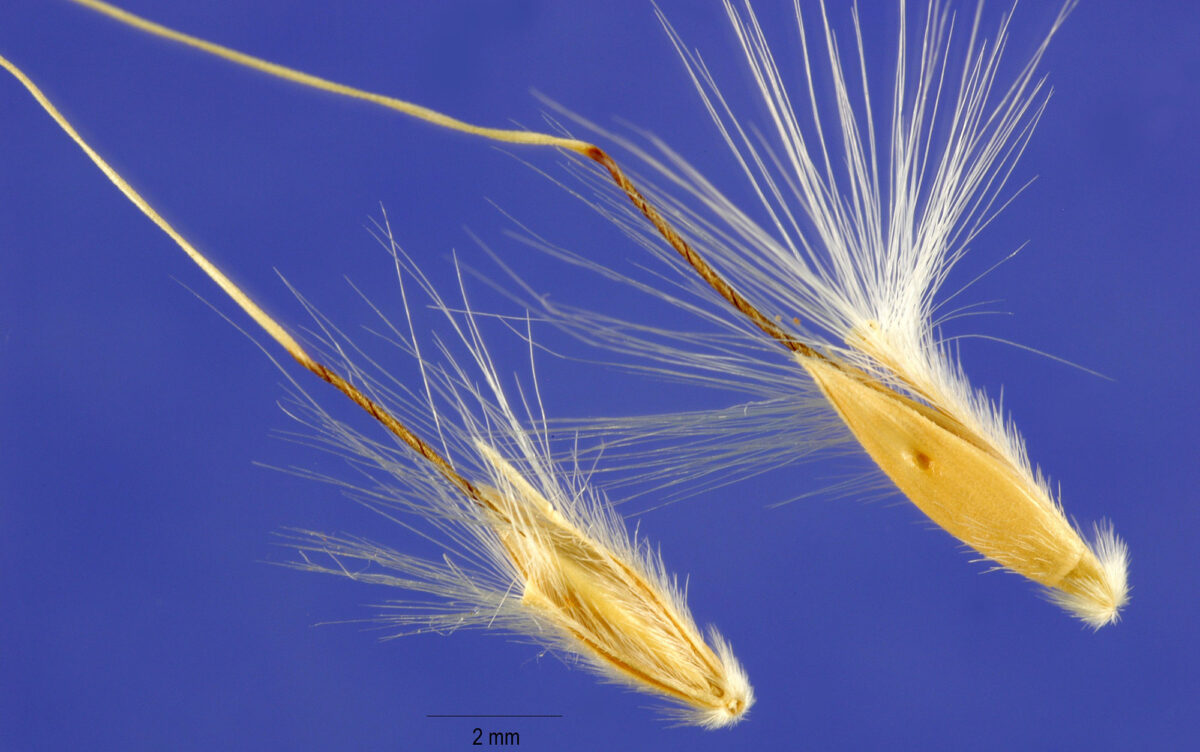Page snapshot: Introduction to the structure of grass plants in Tribe Andropogoneae (the Bluestem or Sorghum Tribe), with an emphasis on leaves and reproductive structures.
Topics covered on this page: Introduction; Leaves; Leaf morphology; Leaf anatomy; Reproductive structures; Inflorescences, spikelets, and florets; Dispersal units; Resources.
Credits: Funded by the National Science Foundation. Any opinions, findings, and conclusions or recommendations expressed in this material are those of the author(s) and do not necessarily reflect the views of the National Science Foundation. Page by Elizabeth J. Hermsen.
Updates: Page last updated January 11, 2023.
Image above: Dispersal units of cane bluestem (Bothriochloa barbinodis). Photo source: USDA-NRCS PLANTS Database (not copyrighted).
Introduction
The purpose of this page is to introduce you to the basic structure of grass plants in the Tribe Andropogoneae, the Bluestem or Sorghum Tribe, including their morphology (form) and anatomy (internal structure). Generally speaking, andropogonoid grasses (meaning grasses in tribe Andropogoneae) are organized like other grasses. Therefore, the emphasis of this page is on their distinguishing features, particularly the structures of their leaves and reproductive parts.
For background on the general structure of the grass plant, visit the following page:
Leaves
Leaf morphology
Morphologically, the leaves of andropogonoid grasses are similar to those of many other grasses. The leaves are divided into sheaths and blades. The leaf sheaths are open, meaning that the edges of the sheath overlap but are not fused to one another. The leaf ligules are membrane-like or made up of hairs.
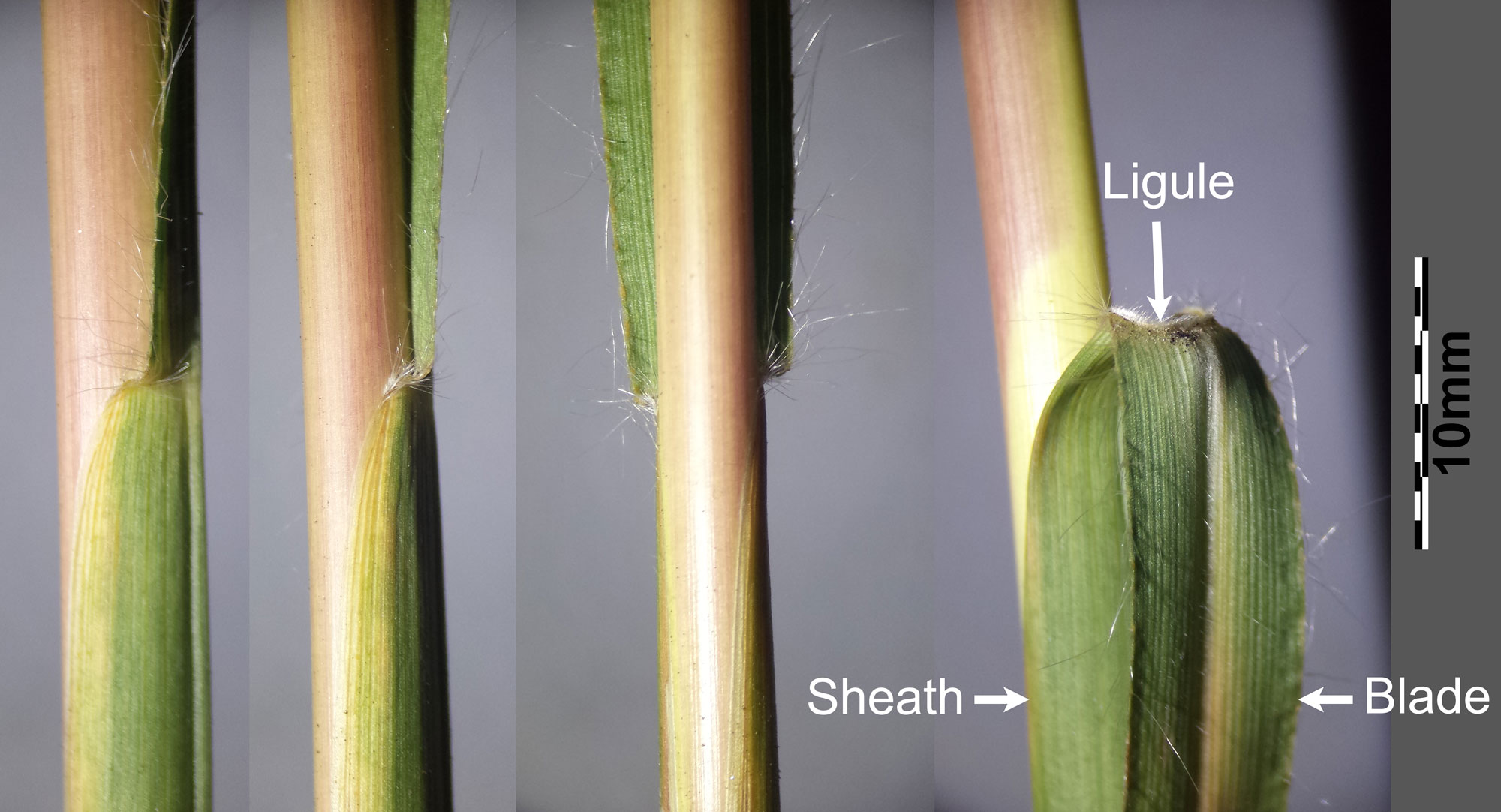
Four views of the leaf blade, leaf sheath, and ligule of false beardgrass (Chrysopogon gryllus). This leaf has no auricle. Photo by Stefan.Iefnaer (Wikimedia Commons, Creative Commons Attribution-ShareAlike 4.0 International license, image labeled and resized).
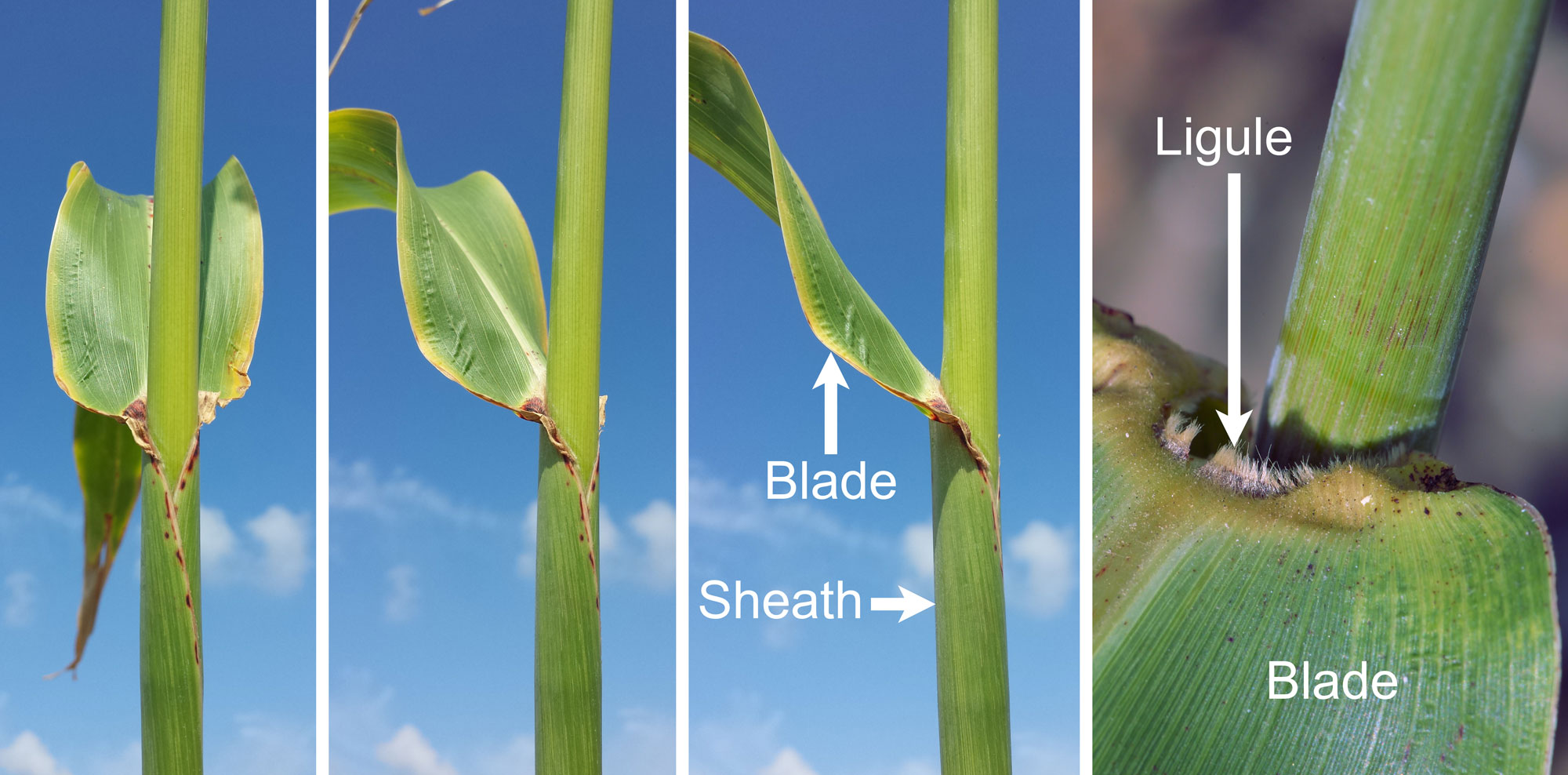
Sorghum (Sorghum bicolor) foliage leaves. Left three panels: Three different views of a leaf showing the sheath and blade. Note that the overlapping edge of the sheath is easy to see in the left image. Right: Close-up of a leaf showing the ligule made up of hairs and a blade. This leaf has no auricle. Left photos one, two, and three by Stefan.Iefnaer (Wikimedia Commons, Creative Commons Attribution-ShareAlike 4.0 International license) and right photo by Rasbak (Wikimedia Commons, Creative Commons Attribution-ShareAlike 3.0 Unported license).
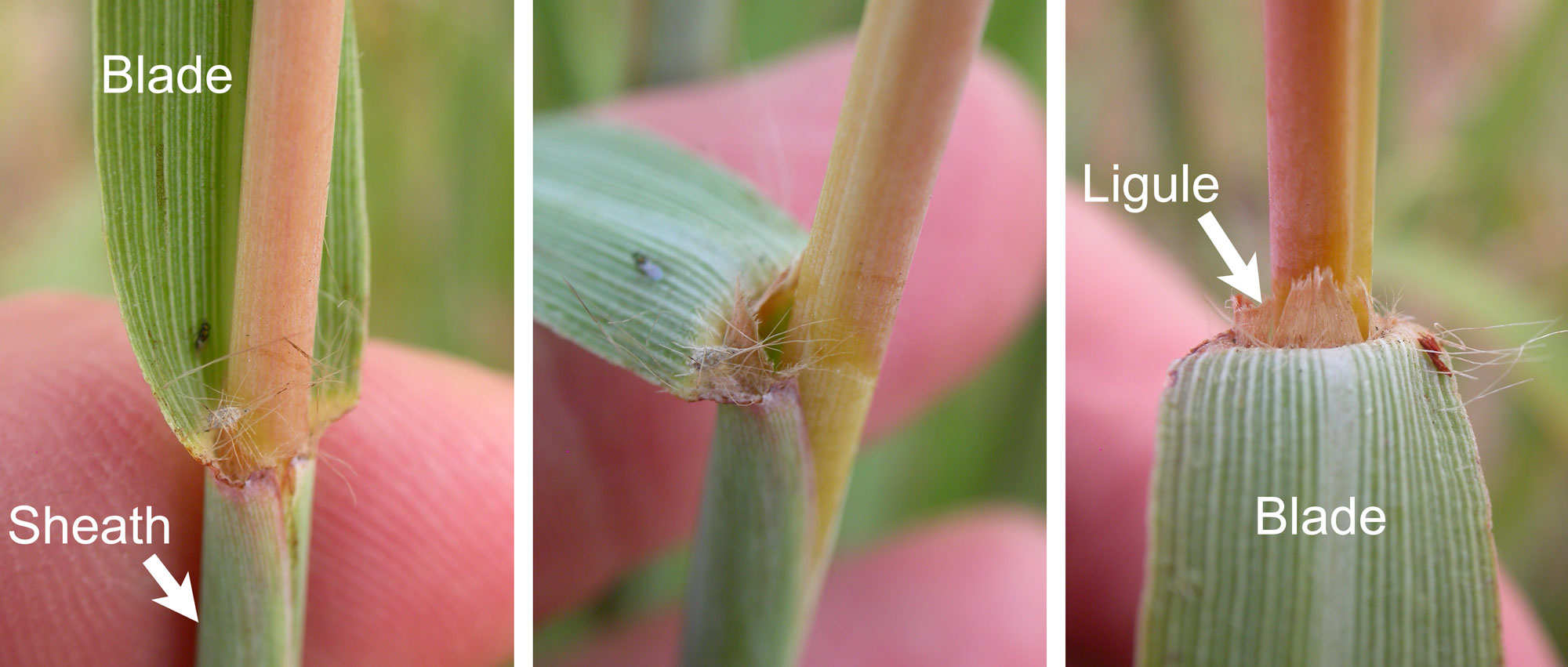
Three views showing parts of the leaf of big bluestem (Andropogon gerardii). Photos one, two, and three by Matt Lavin (Wikimedia Commons, Creative Commons Attribution-ShareAlike 2.0 Generic license, images cropped, resized, and labeled).
Leaf anatomy
Leaf epidermis
As in other grasses, the leaf epidermis of andropogonoid grasses is made up of rows of cells that parallel the length (the long axis) of the leaf. These cells include long cells, short cells, bulliform cells, and the guard cells and subsidiary cells surrounding the stomata (pores).
Some short cells are silica cells that contain silica bodies. Silica bodies or phytoliths in andropogonoid grasses tend to be of the panicoid type, ranging from cross-shaped to bilobate (dumbbell-shaped) to polylobate.

Microscopic image of maize (corn, Zea mays) epidermis showing three stomata with guard cells and subsidiary cells. In this image, the stomata are closed. The cells between the stomata are interstomatal cells, a type of long cell (although in this image, relatively short). Photo by Umberto Salvagnin (flickr, Creative Commons Attribution 2.0 Generic license, image labeled).
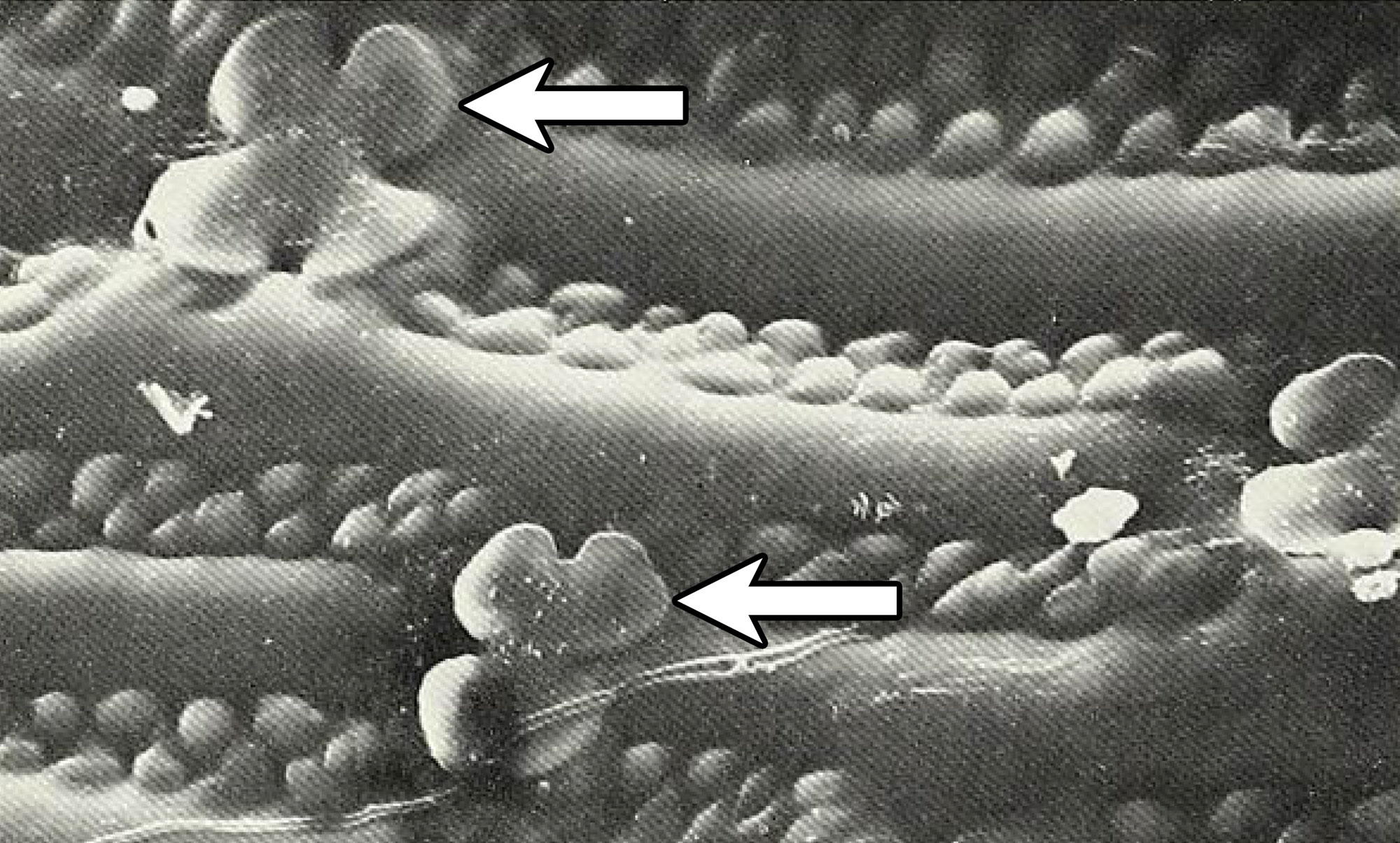
Scanning electron micrograph (magnified photograph taken with a scanning electron microscope) showing cross-shaped silica bodies (arrows) in the epidermis of the leaf of the African grass Phacelurus huillensis (Tribe Andropogoneae, subtribe Rottboellinae). Source: Figure 5 from Palmer and Tucker (1981) Smithsonian Contributions to Botany 49 (Biodiversity Heritage Library, Creative Commons Attribution-NonCommercial-ShareAlike 4.0 International license, image cropped and white arrows added).
Leaf vascular bundles (veins)
Andropogonoid grasses are C4 grasses. In C4 grasses, the light reactions of photosynthesis take place in the mesophyll cells, whereas the carbon-fixing reactions take place in the bundle sheath cells. The mesophyll cells are arranged concentrically around the bundle sheath cells in a pattern known as Kranz anatomy (Kranz is German for wreath). Unlike some other C4 grasses which have a two-layered bundle sheath, andropogonoid grasses have only a single layer of bundle sheath cells with chloroplasts.
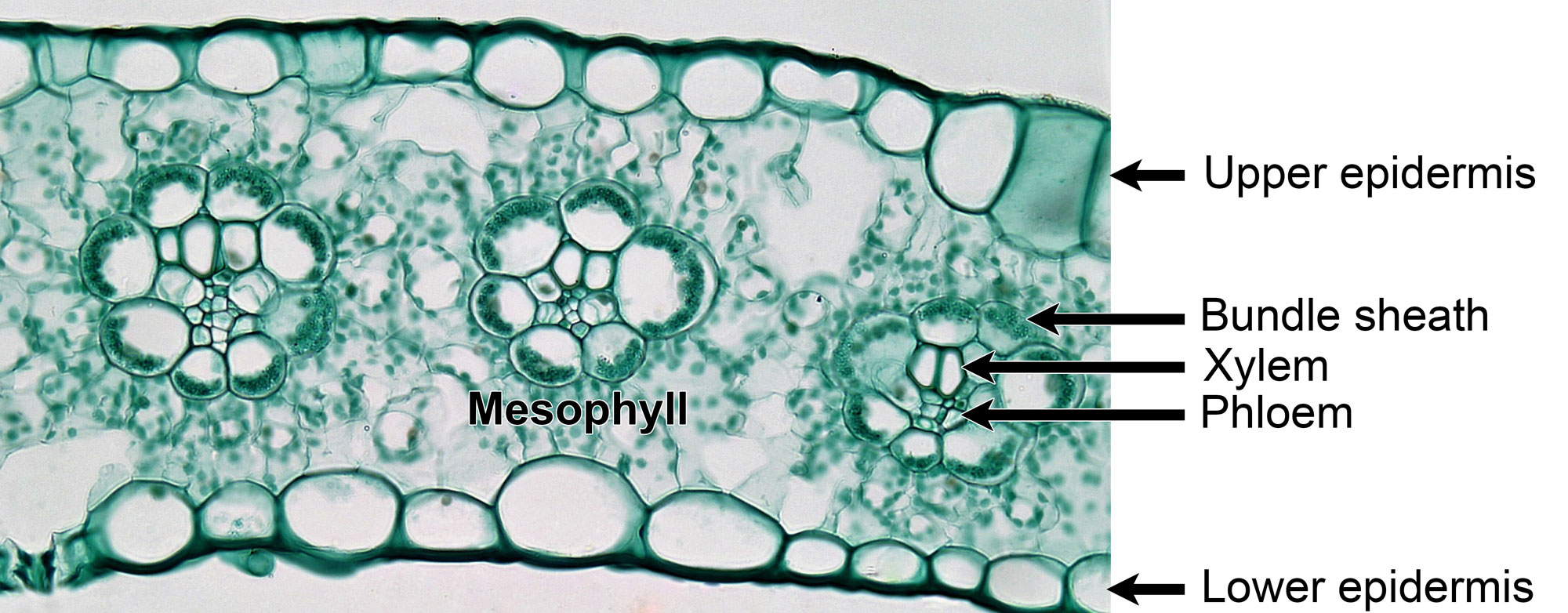
Fixed and stained cross section of a leaf of maize (corn, Zea mays) showing three veins, each with vascular tissue surrounded by a bundle sheath. Mesophyll cells encircle the bundle sheaths. Photo by Berkshire Community College (flickr, CC0 1.0 Univerisal/public domain dedication).
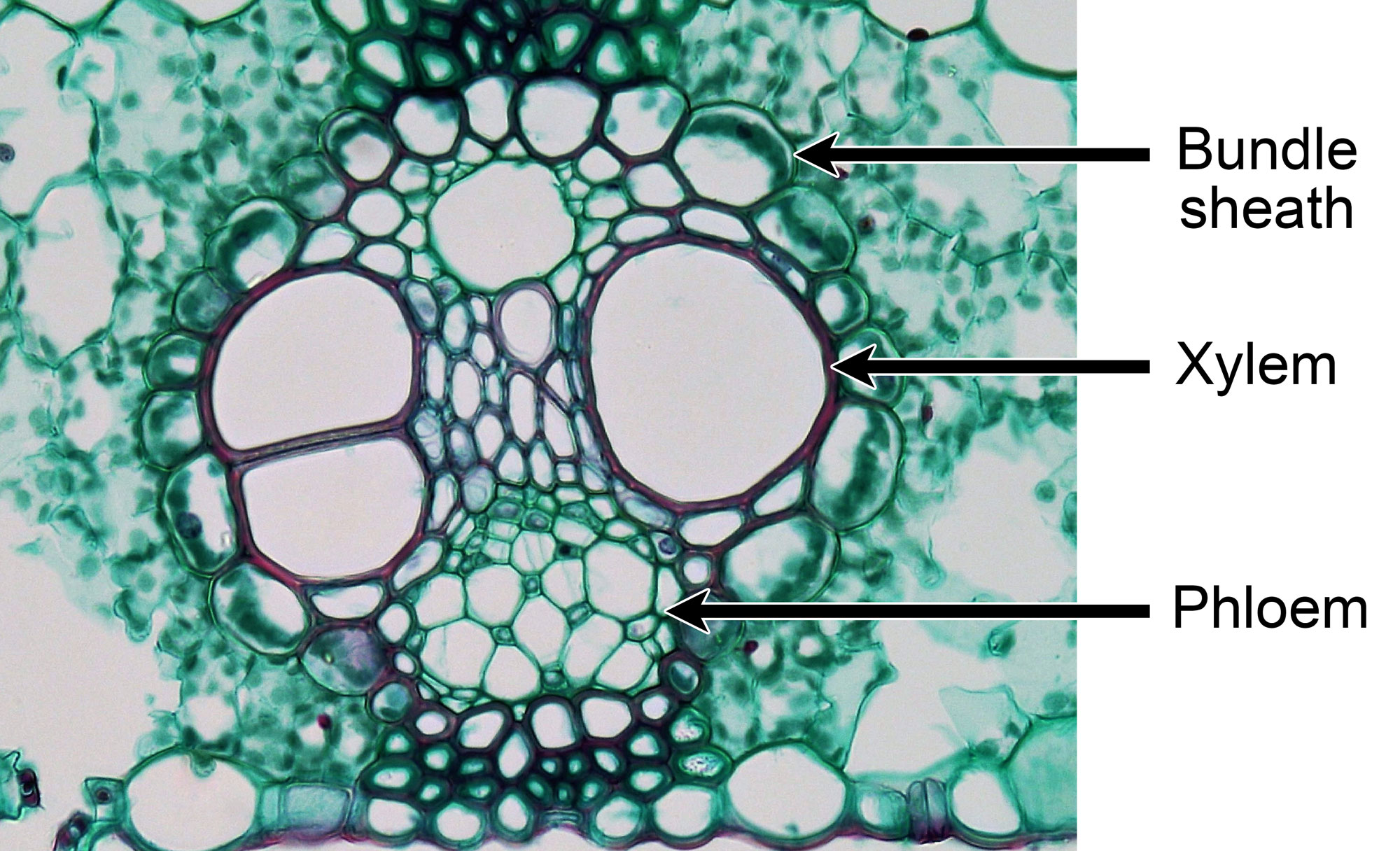
Fixed and stained cross section of a leaf of maize (corn, Zea mays) showing a large vascular bundle encircled by a bundle sheath. Maize is a C4 grass. Photo by Berkshire Community College (flickr, CC0 1.0 Univerisal/public domain dedication).
Reproductive structures
Grasses in Tribe Andropogoneae may be dioecious (have male, or pollen-producing, and female, or ovule-producing, florets on different plants), monoecious (have male and female florets on the same plant), or may have bisexual florets (florets with both male and female structures).
Inflorescences, spikelets, and florets
The inflorescences of members of Tribe Andropogoneae may occur at the ends of stems or in the leaf axils (the upper angle between leaf and stem) on the sides of stems. The overall structure of the inflorescence varies, but, in general, inflorescences are made up of clusters of branches. These branches may diverge from a single point at the end of a stalk or may branch off the sides of a central inflorescence axis.
Spikelets typically occur in pairs on branches. They may also occur in groups of three (triplets), particularly at the ends of branches, or, sometimes, one at a time on a branch. The inflorescence branches that bear the groups of spikelets are called rames. Rames usually disarticulate (break apart, also called shattering) when the fruit is mature. Some botanists consider rames to be a unique to Tribe Andropogoneae.
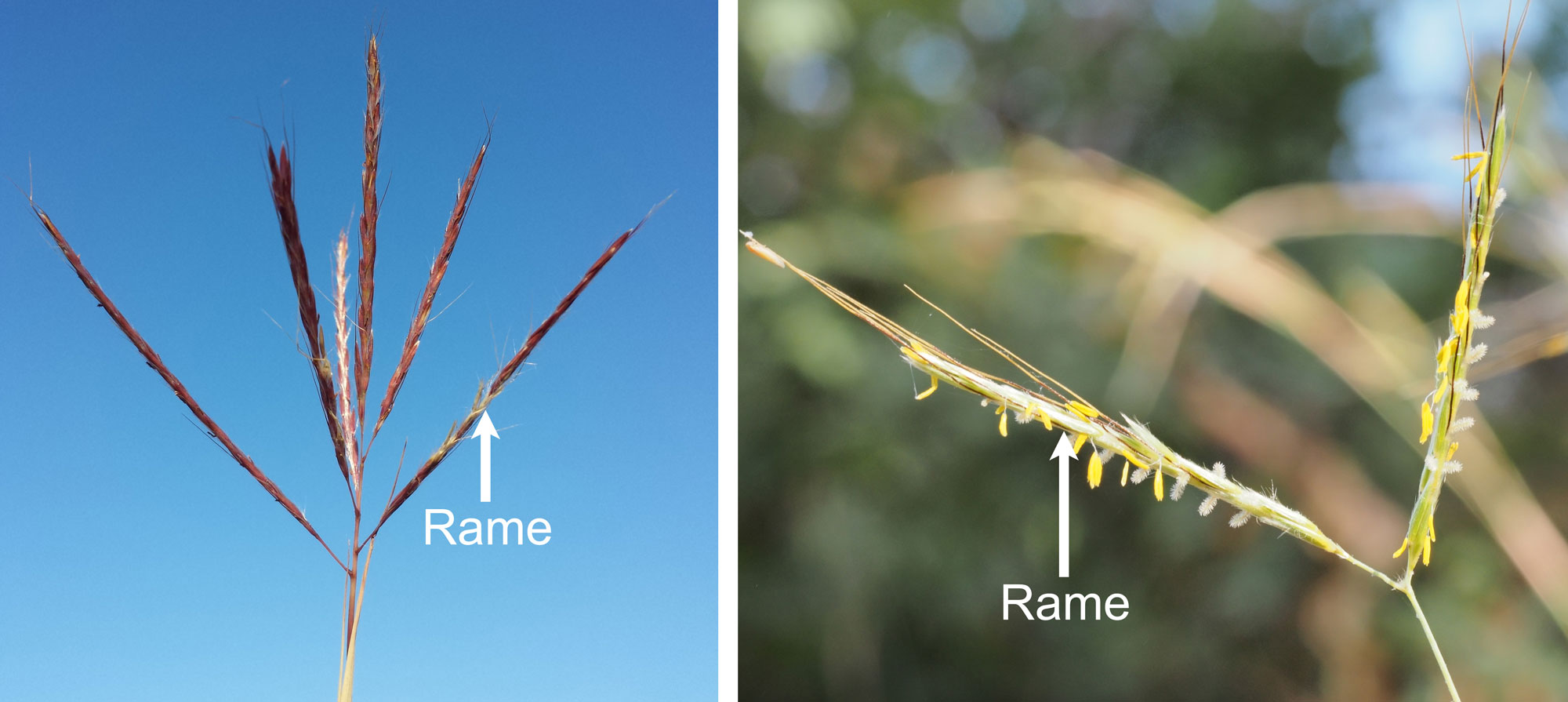
Examples of inflorescences of members of Tribe Andropogoneae. Left: Yellow bluestem (Bothriochloa ischaemum). This inflorescence is a panicle. It has a central axis (stem) with lateral branches. Right: Thatching grass (Hyparrhenia hirta) with two rames. This inflorescence is a digitate inflorescence. In a digitate inflorescence, the branches are attached to a single point. Left photo by Stefan.Iefnaer (Wikimedia Commons, Creative Commons Attribution-ShareAlike 4.0 International license); right photo by Luis Fernández García (Wikimedia Commons, Creative Commons Attribution-ShareAlike 4.0 International license). Image cropped, resized, labeled.
Spikelet pairs may include two pedicellate (stalked) spikelets, one sessile (stalkless) spikelet and one pedicellate spikelet, or two sessile spikelets. Typically, two glumes occur at the base of each spikelet. Spikelets may be bisexual (both male and female, or producing both pollen and ovules), unisexual (female or male) or sterile. Sterile spikelets produce neither pollen nor ovules, and their reproductive structures do not develop fully, if they develop at all; typically, sterile spikelets consist only of bracts (for example, glumes, lemmas, and paleas).
Each spikelet bears two florets. As with spikelets, individual florets may be bisexual, female, male, or sterile. The lemmas of the florets may be thin, and the paleas thin or even absent. Bisexual and male florets have three anthers.
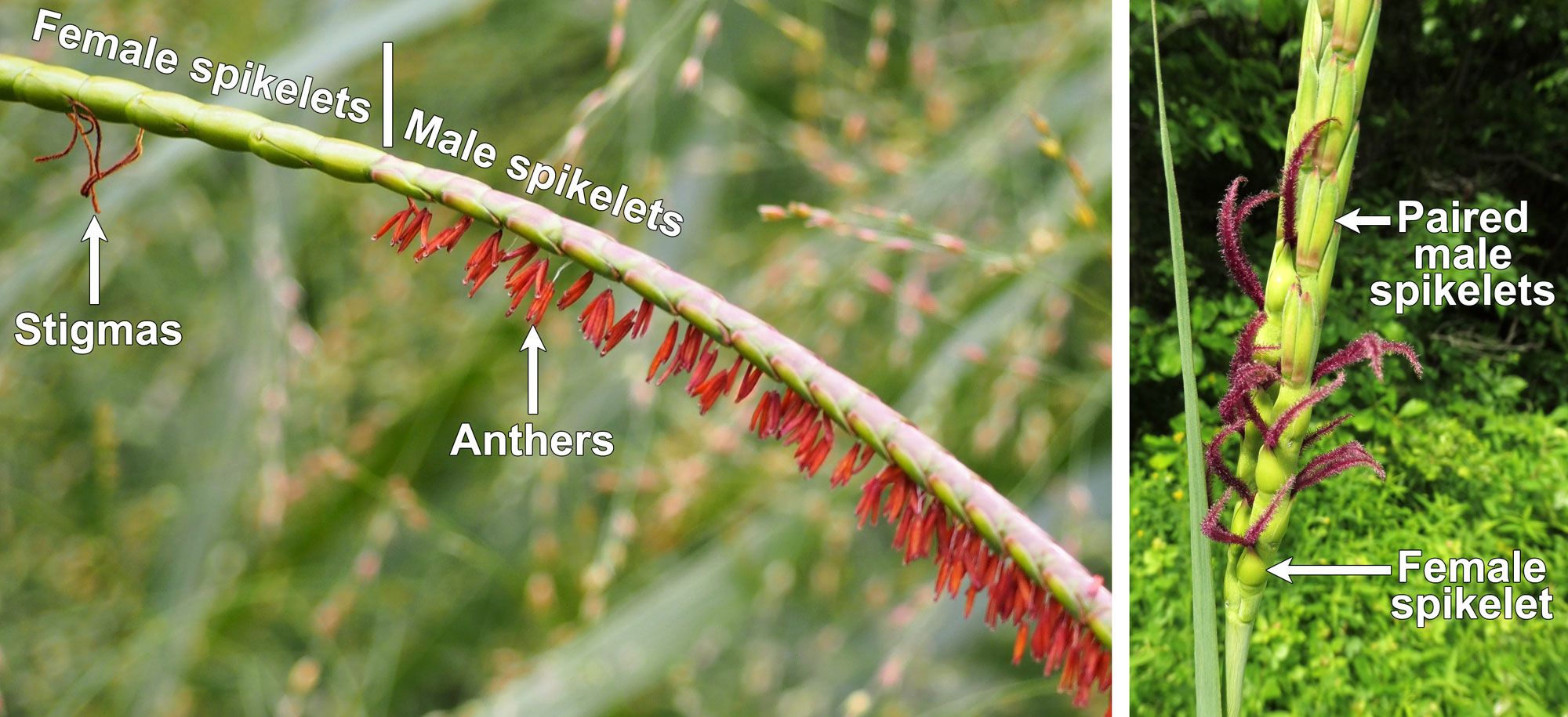
Rames of eastern gamagrass (Tripsacum dactyloides). In this grass, female (pistillate) spikelets are near the base of the rame, and male (staminate) spikelets are near the apex. The female spikelets are solitary, with one female and one sterile floret each. The male (staminate) spikelets are paired. On this rame, all spikelets are sessile. Left photo by Agnieszka Kwiecień, Nova (Wikimedia Commons, Creative Commons Attribution-ShareAlike 4.0 International license), right photo by Mason Brock/Masebrock (Wikimedia Commons, public domain); photos cropped, resized, and labeled.
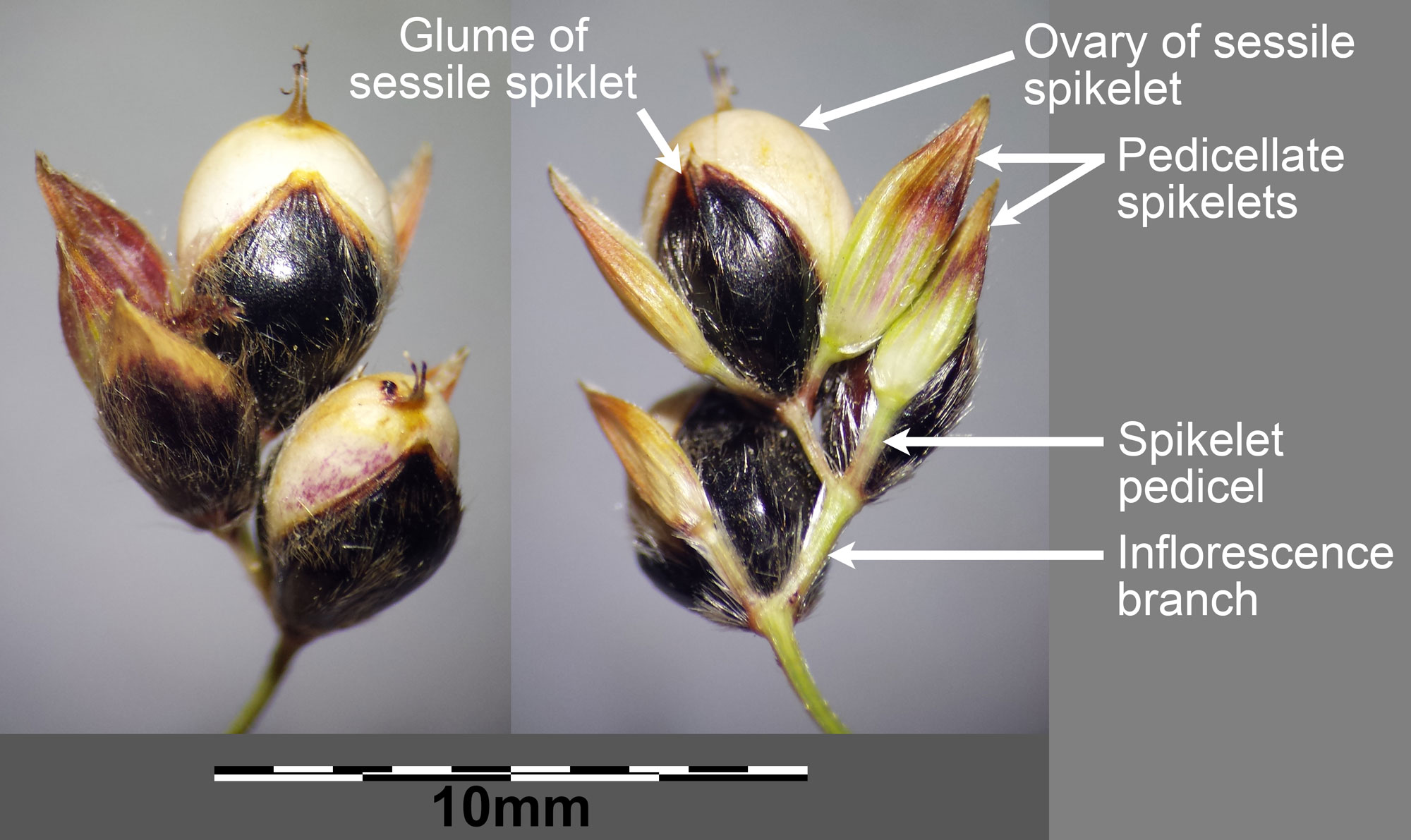
Sorghum (Sorghum bicolor) spikelets in two views. Sorghum has sessile and pedicellate spikelets. The sessile spikelets are bisexual (male and female), whereas the pedicellate spikelets may be male or sterile. Note that the terminal group of spikelets in the photo above is a triplet, whereas the other two groups of spikelets are pairs. Photo by Stefan.Iefnaer (Wikimedia Commons, Creative Commons Attribution-ShareAlike 4.0 International license, image resized and labeled).
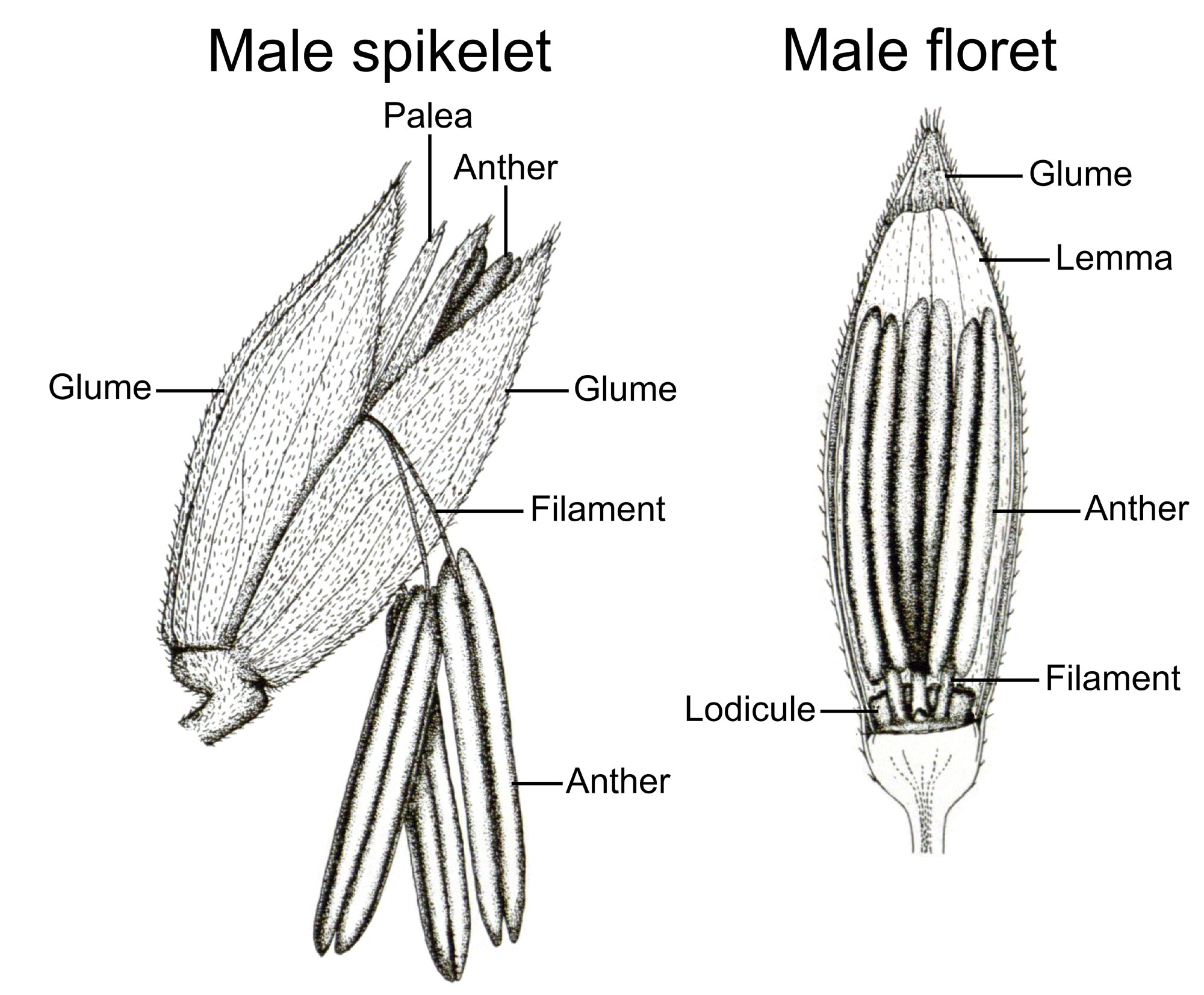
Diagrams of a maize (Zea mays) male (staminate) spikelet and male (staminate) floret. Left: Male spikelet with two florets, one of which is open with stamens protruding. Note that the lemmas are not labeled because they are under the glumes, and thus not visible in the drawing. Right: A single dissected male floret. Note that the palea is not labeled because it has been removed to expose the stamens. Source: Plate 5, figs. 1 and 2 from Weatherwax (1916) Bulletin of the Torrey Botanical Club 43: 127-144 (Biodiversity Heritage Library, public domain).
Dispersal units
In wild members of Tribe Andropogoneae, the rames (inflorescence branches that bear the spikelets) disarticulate (shatter or break apart) when the fruit is mature. If spikelets are solitary on a rame, the rame will break beneath each spikelet. If spikelets are paired or in groups of three (triplets), the rame typically breaks apart at the base of each pair or triplet of spikelets. Thus, each spikelet pair or triplet is dispersed as a unit, often with a small segment of the rame (branch) still attached.
In domesticated members of Tribe Andropogoneae that are grown for their grain, like maize (Zea mays) and domesticated sorghum (Sorghum bicolor subsp. bicolor), the inflorescences often do not shatter (break apart). Non-shattering inflorescences were selected for during domestication, probably to make grain easier to harvest and to prevent the loss of grain.
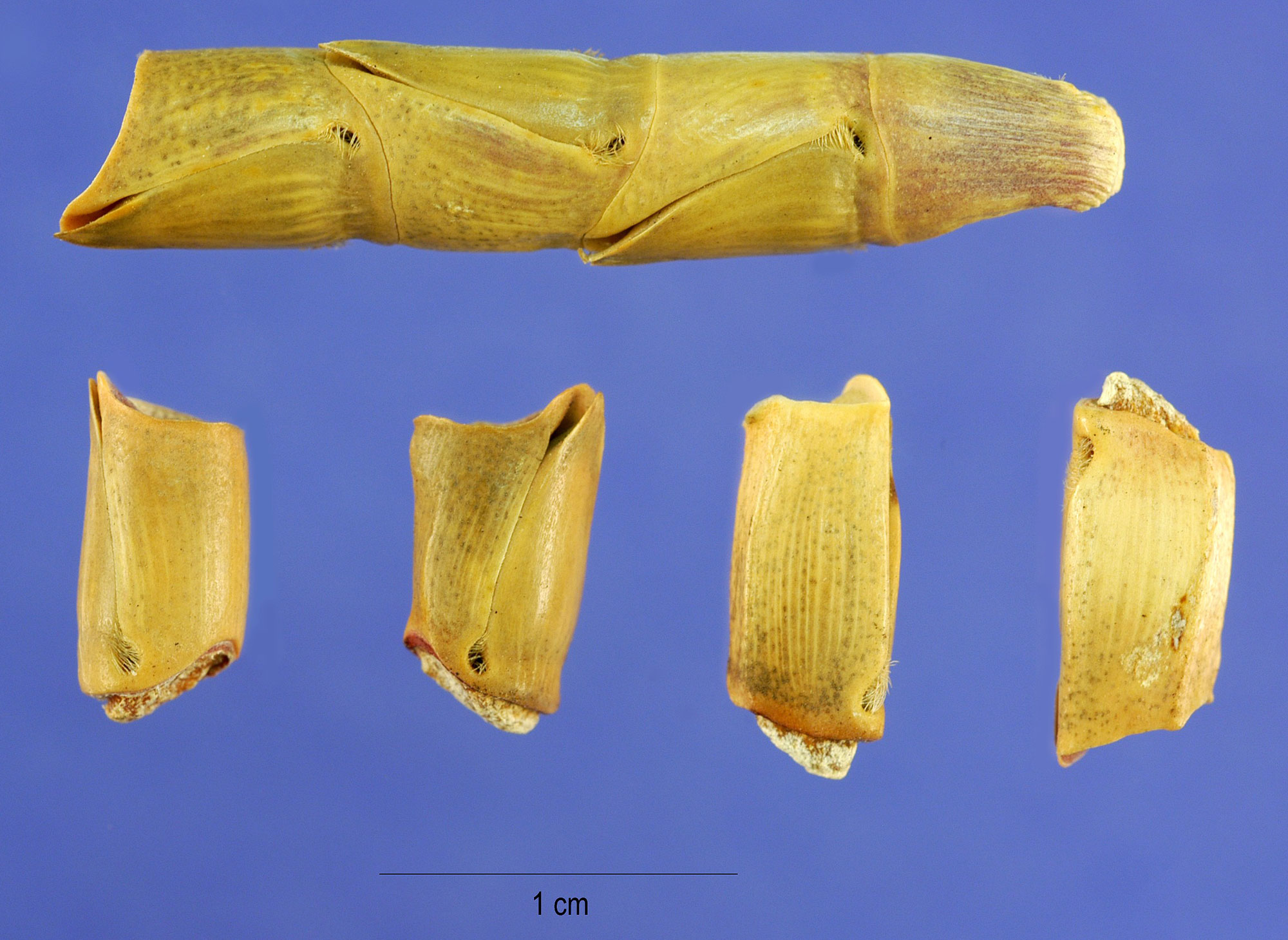
Part of a rame of eastern gamagrass (Tripsacum dactyloides). In this grass, male (staminate) spikelets occur near the tip fo the rame, and female (pistillate) spikelets occur near the base of the rame. The female (pistillate) spikelets occur singly on the rame. When the fruits are mature, the rame breaks apart between each pistillate spikelet. The hard fruitcase surrounding each fruit is made up partially by the rame axis and partially by the hardened glumes of the spikelet. Above: Portion of rame with mature female spikelets still connected. Below: Individual fruits in hard fruitcases. Photo source: USDA-PLANTS Database. (not copyrighted).

Dispersal unit of common wild sorghum (Sorghum bicolor subsp. arundinaceum). In this grass, spikelets occur in pairs, with one pedicellate and one sessile spikelet. The rame breaks apart beneath each sessile spikelet. The dispersal unit consists of a pedicellate spikelet, a sessile spikelet (the grain or caryopsis), and a branch internode (section of the rame axis). The long awn is on the lemma of the sessile spikelet. Photo source: USDA-PLANTS Database. (not copyrighted).
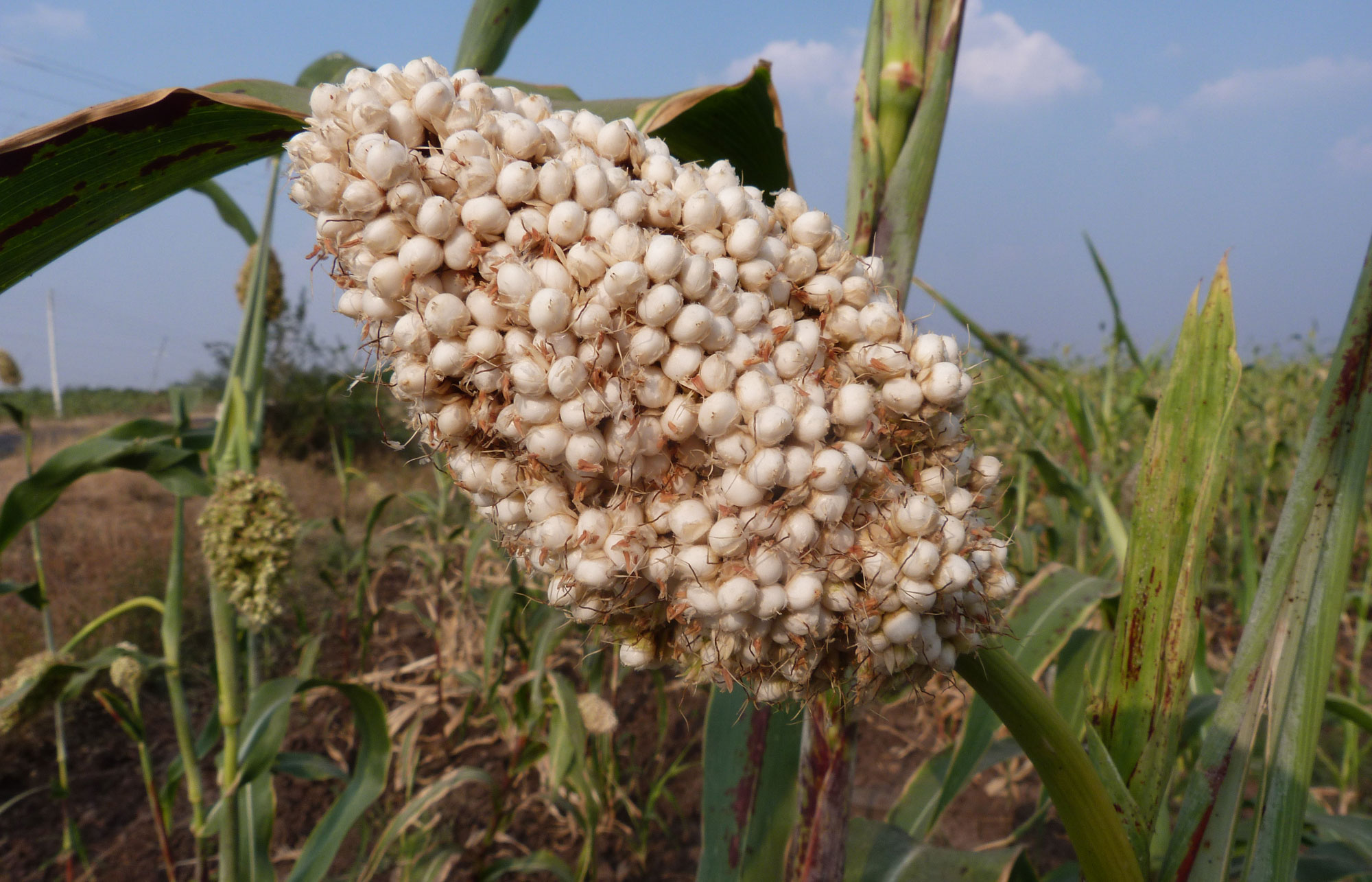
Domesticated sorghum or jowar (Sorghum bicolor subsp. bicolor), Maharashtra, India. In cultivated sorghum, the inflorescence typically does not disarticulate. Photo by MGB CEE (Wikimedia Commons, Creative Commons Attribution-ShareAlike 4.0 International license, image cropped and resized).
Resources
Websites
Additional resources from the Paleontological Research Institution
Digital Encyclopedia of Ancient Life: Introduction to Vascular Plant Structure: https://www.digitalatlasofancientlife.org/learn/embryophytes/tracheophytes/
Other websites
Glossary of botanical terms used in Poaceae (Flora of China online): http://flora.huh.harvard.edu/floradata/002/vol22/poaceaeglossary.htm
Articles, books, and other literature
Bauer, M. M. Beginners grass identification workshop. University of Arizona Herbarium. PDF: https://cals.arizona.edu/herbarium/sites/cals.arizona.edu.herbarium/files/pdf/BeginningGrassID_2018-06-07.pdf
Scientific articles and books
Clark, L. G., and E. A. Kellogg. In Flora of North America Editorial Committee, Flora of North America North of Mexico vol. 24. Poaceae. Accessed online at: http://floranorthamerica.org/Poaceae
Esau, K. 1977. Anatomy of seed plants, 2nd. ed. John Wiley and Sons, New York.
Kellogg, E. A. 2015. Flowering Plants, Monocots, Poaceae. The Families and Genera of Vascular Plants 13, 416 pp. (K. Kubitzki, ed.). Springer International Publishing, Switzerland. https://doi.org/10.1007/978-3-319-15332-2_1
Twiss, P. C., E. Suess, and R. M. Smith. 1969. Morphological classification of grass phytoliths. Proceedings of the Soil Science Society of America 33: 109-115.



